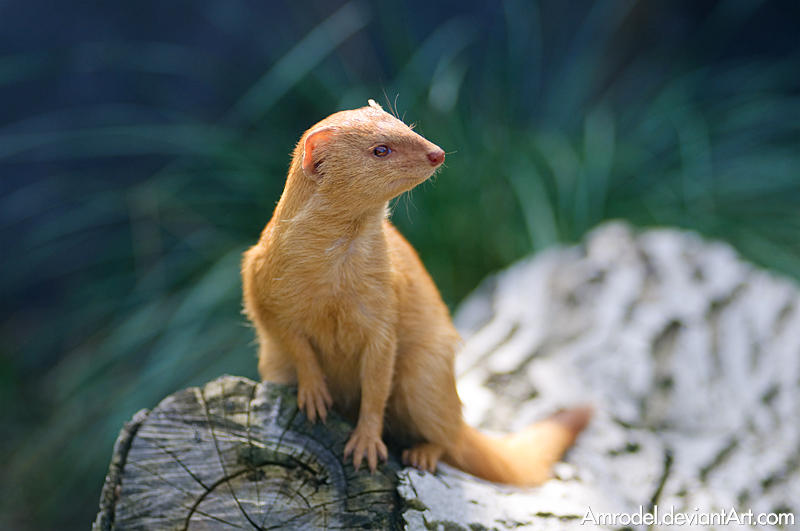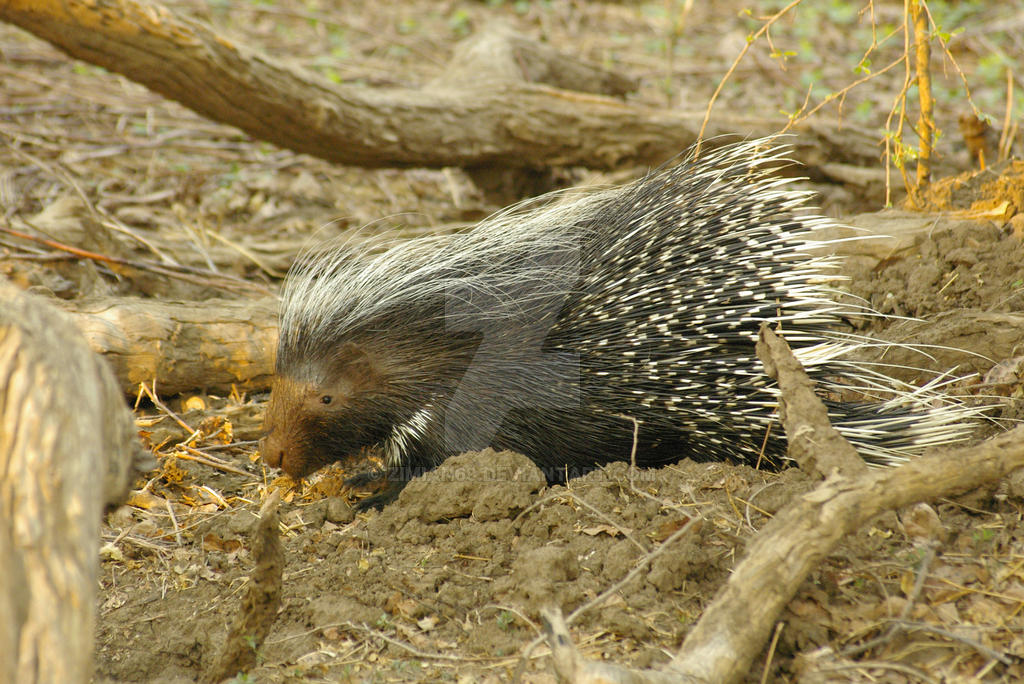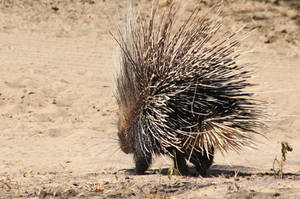Travelling through Southern Africa and parts of Australia looking at and photographing wildlife has been an extraordinary life-enhancing experience. Whether it is elephants trumpeting, lions roaring, giraffes necking or kangaroos hopping mad, these are the moments of excitement that we never forget. Yet, very early on in my travels I realised that there are many, many animals and birds that are equally fascinating and whose lives are just as dramatic and intriguing as the boldest and best of the Big Five. They tend to be overlooked on safari when most of the visitors want to see the hippos yawning or the leopard stalking. I thought it might be useful to have a Feature on some of these overlooked animals, indeed in some cases rare animals. DeviantArt has an enormous database of photographs from hundreds of thousands of people some of whom, like me, have a special interest in wildlife. I thought there would be no problem in finding shots of these creatures in the wild from the archives of DeviantArt. However, that is not the case. While there are hundreds of shots of the big beasts and birds, including now some of mine, there are few of animals such as the pangolin, the honey badger, and the oranutan in the wild. Many photographers use zoos as a source of wildlife shots, and some of the less well known species have been captured on camera in such environments. Yet, there is nothing quite like getting the shot in the wild - opportunities to witness behaviour unlikely to be seen in captivity.
Here is a small selection of photographs of the less frequently encountered animals that I have not seen or photographed, but would dearly love to snap, the shots being from both the wild and zoos.
The Pangolin
www.awf.org/wildlife-conservat…

Nick,
thalien, managed to capture this shot of a pangolin on a recent trip to Africa. Pangolins are scaly ant-eaters, that is their diet comprises insects of which ants are a major component. They are found in Asia and Africa, most species being nocturnal and so difficult to spot during the day. They are scaly, and roll up into a ball when threatened by potential predators. I have include here a second photograph, from
Pale-Recluse which I think is taken at a zoo but which shows the strong claws used by the pangolin to burrow into insect nests, and the tip of what turns out to be a very long tongue, in some species as much as 40 centimeters. Unfortunately, pangolins are now an endangered species, with the worst predator being Man whose appetite, at least in parts of Asia, for pangolin meat is seemingly insatiable.
The Honey Badger
www.honeybadger.com/There is nothing honey-like nor badger-like about this inappropriately named species. The excellent capture by Hermanus
Living-Wild who is a conservationist working in Namibia shows this smallish mammal (typically about 1 meter long including tail and weighing between 9 and 16 kilos) having a drink, but with a wary eye on its surroundings. Honey badgers, found in Africa, Asia, and India, are part of the mustelid family of animals, weasels and stoats in the UK being part of the same family. Honey badgers are highly ferocious carnivorous animals whose anatomy, thick skin, and high intelligence have given the species a fearsome reputation. There is even one recorded case of a honey badger killing a lion by slicing through the jugular vein with its sharp claws. Although not particularly rare in the wild, these guys are hard to spot and not at all friendly. The second shot is by
AngelXPoison with reference made to the animal rooting around outside a tent. I doubt this is a zoo shot, and I guess the photographer is lucky to still have all fingers and toes intact!


The Slender Mongoose
www.krugerpark.co.za/slender_m…Hermanus has also captured this magnificent shot of the slender mongoose. As he says in the description, "
A Slender Mongoose shows his teeth in retaliation of the invasive photographer. This is probably the first time this animal has seen a human ... and he was not impressed. Photographed in the complete wilds of Namibia, southwestern Africa." The slender mongoose is a common species in Southern Africa, but there is considerable variability in the colour of its fur, and as many as 50 (!!) subspecies. Considered a pest because of its attacks on domestic fowl and because it is a known vector of rabies, attempts have been made to kill it off, but to no avail. There are many species of mongoose, and I've captured images on banded and dwarf species, but never of this type. The second shot, by Monika amrodel suggests zoo life is not a problem!

The African Wild Dog
animals.nationalgeographic.com…

I'm including two shots of this wonderful African animal, one by Morkel
MorkelErasmus a professional wildlife photographer based in Southern Africa, and the other by another South African, Edward,
NagWolf. African wild dogs, also known as the hunting or painted dog on account of their highly colourful fur, is now an endangered species, mainly from habitat destruction and persecution. A carnivorous species, it specialises in hunting down antelope, chasing them to exhaustion before the kill. It has a highly socialised family structure, and hunts as part of a pack. While the remains of their kills are often found, they can be elusive to find and photograph. The shot from Morkel shows a typical sighting of wildlife in early morning - coming across the animals by chance and skillfully capturing the light as well as the animals themselves. Note, the front of the vehicle is showing - a good sign of the realities of shooting in the wild. The shot from Edward shows the dark side of the wild - the bloody features of a wild dog after gorging on a kill.
The Tasmanian Devil
www.parks.tas.gov.au/?base=387Jumping continents to Australia, but keeping the fearsome theme, you may encounter the Tasmanian Devil. Another ferocious carnivorous hunter and carrion eater, this small marsupial is thought to have one of the most powerful bites per unit body mass of any living mammal. They are now found only in the island state of Tasmania, having died out on the main Australian continent. The shot from Cameron
Cameron-Jung appears to have been taken in the wild, while the second from Danielle
daniellepowell82 is a zoo shot. The species is now facing an uncertain future, not from Man this time, but from the appearance of a fatal disease that leads to facial tumours.


The Porcupine
www.awf.org/wildlife-conservat…This fabulous shot by
zimian69 of a porcupine in the wild (Zimbabwe) (left side image below) gives us all a chance to see this magnificent creature "au naturel". Despite many attempts by the most experienced guides and rangers on my numerous safaris, I have never seen one "for real". However, visits to game reserves and lodges are often marked by one of the staff presenting you with one or more porcupine quills, an act representing friendship between peoples. Beware, however, how you hold such a present - those tips are very, very sharp, giving a very painful stab to the unwary. Porcupines of different sub-species are found in many parts of the world other than Africa - the Americas, Southern Europe and Asia. However, seeing one in the dusty bush of Southern Africa would be a treat indeed. Porcupines are a type of rodent, they can grow to almost a meter in length and weigh up to 15 kilos. Their principal defence mechanism against predators is to roll into a ball with those quills bristling outwards - not even the most foolhardy young lion would try to breach such a spiky challenge. They are herbivores that are known to climb trees to find tasty leaves and twigs. The second image is another from Hermanus
LivingWild, an image that shows in detail the formidable array of spines.


The Orangutan
www.orangutan.org.uk/Finally, as I think I have overrun my initial intention to limit this Feature to about 10 images, I want to mention the orangutan with images from Prairie
Saltychocolate101 and Nik
OrangeRoom, the first being a shot from the wild in Sumatra, the second a zoo shot. This animal brings me back to one of the themes of this Feature - lots of shots of rare animals in captivity as per the excellent and touching madonna and child shot from Nik, but very few shots from the wild, as per that from Prairie. The plight of the orangutan must be known to nearly everyone - declining numbers from habitat destruction and persecution, yet one of the primates most closely resembling Mankind in behaviour and intelligence. Found in Indonesia and Malayasi, predominantly Borneo and Sumatra, the orangutan is a mainly arboreal great ape living on fruit and foliage, and leading a rather solitary life compared to the great apes of the African continent. The plight of the orangutan is often taken as representative of the unthinking and uncaring way in which Mankind has exploited the natural environment. While there is truth to this assertion there are conservation measures in action to protect this species, although there is a long way to go before it will be out of danger.


That is all for now. I've tried to highlight some of the lesser known animals, particularly in Southern African with some excursions to Asia and Australia, to show the rich diversity of wildlife over and above the popular species of the Big Five and the like. While DeviantArt has a large database of wildlife photographs, these relatively unknown species do not have that many illustrations here other than from animals in captivity. We need to attract more photographers like Morkel
MorkelErasmus and Erasmus
LivingWild to join and share their work.
Cheers
David
Note: I have not given the scientific names for these creatures, mainly because there can be several species with slightly different taxonomies. Details can, however, be found in the links that are given for each animal.














